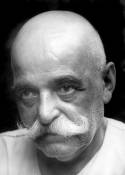
Gurdjieff International Review
The Patriarch Goes West
by William Segal
Animated by an essentially pragmatic point of view, Americans were immediately attracted to the ideas of Gurdjieff. What could have spoken more forcefully to a people formed by a tradition of practical realism, disdainful of mere theory, and not hemmed in by abstract principles, than this teaching which had daily life for a field of application?
At all levels, in all strata of United States society, an implicit question dominates: “Does it make sense?” In the mirror he held to mankind, Gurdjieff indicated the fundamental incapacity of men and women lacking a highly developed unbound attention to make contact with an omnipresent sacred reality. For many Americans, that did make sense—especially in America’s mid-twentieth century period of skepticism and disillusionment. In the post World War II period of transition and beginning, simultaneous with the progressive diffusion of Eastern teachings, Americans were understandably uneasy with religious formalism. It was one of those rare moments when people were hungry for deeper, more authentic modes of life.
The ideas of Gurdjieff and his precise, practical work methods did not influence only the thin strata of avant-garde intellectuals. Gurdjieff’s ideas were viewed with considerable interest and warmth by corresponding circles connected to spiritual life, in particular such Zen figures as Daisetz Suzuki, Shinichi Hisamatsu, Rev. Asahina, Soen Nakagawa, and Nanrei Kobori.
No doubt there is a profound connection between Zen and the teaching of Gurdjieff, in that they both propose that only with tough disciplines and practice is it possible to relate to a “changeless self.” Theory without practice, words without an immediate connection to experience, is for followers of both Zen and Gurdjieff as fruitless as “pouring from the empty into the void.” Similarly, for students of Gurdjieff, the dualistic separation of body and mind, the material and the spiritual, stuffing oneself with knowledge without developing corresponding being can only impede the circulation of life and lead to the destruction of the humanness of humanity.
Gurdjieff came, bringing with him a body of ideas which renewed access to many perspectives, attracting artists, scientists, philosophers, religious and lay persons. He showed a way that could be followed in the midst of ordinary activities, a way that did not call for cloister or blind obedience, a way indicated by the words of the Japanese poet, Takashi Tsujii:
Simply by the act of cutting stone
he measured the distance
between himself and the Supreme.
This essay was previously published in Gurdjieff: Essays and Reflections on the Man and His Teaching, New York: Continuum, 1996.
|
Copyright © 1996 William Segal This webpage © 1999 Gurdjieff Electronic Publishing Featured: Fall 1999 Issue, Vol. III (1) Revision: June 1, 2019 |